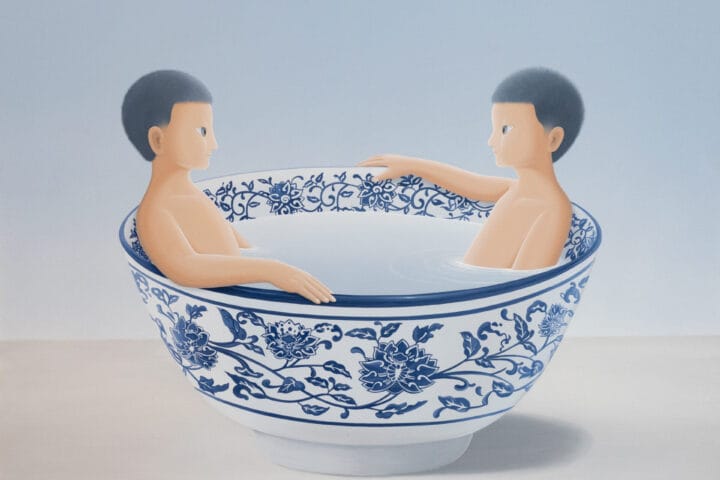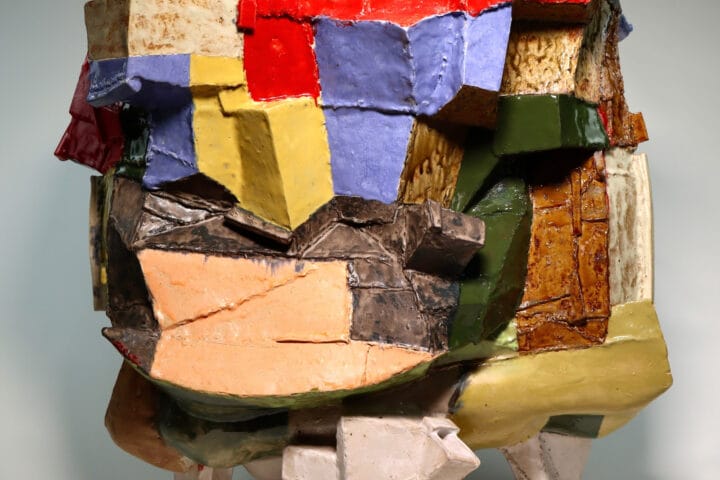‘and we’ll make art out of the time of our lives
– Monica Ross
that is always between one job, one role and another’
The Time of Our Lives focuses on the pioneering drawing practices of women artists and their impact on feminist activism from the 1980s until today. The exhibition showcases the work of key artists, including Venice Golden Lion winner Sonia Boyce, Claudette Johnson and Sutapa Biswas, examining drawing’s versatility as a medium and the ways it has been used by women to raise consciousness around social and political issues, such as reproductive justice, sexism, racism and other forms of oppression.

State of Emergency, 1992, durational performance and installation, knife bound in gold cord, electric fan, candle, pillowcase filled with sand, outdoor walls covered in charcoal, Blind Montage Festival, die MelkFabriek, S’HertogenBosch, Holland, August 29–30, 1992, Photograph © Bernard G Mills, courtesy the MonicaRossArchive.org
Working both independently and collaboratively, often without commercial or institutional support, the voices of these agents for change are now being heard and their trailblazing work taken forward by a contemporary generation of women artists. Beginning with drawings made by Monica Ross in the 1980s, the exhibition will include works by Sutapa Biswas, Sonia Boyce, Margaret Harrison, Claudette Johnson, Lizzy Rose and Soheila Sokhanvari, and includes new commissions by Kate Davis and Jade de Montserrat.
About the Artists
Sutapa Biswas (b.1962) is a British Indian conceptual artist, who works across a range of media including painting, film, time-based media and drawing. In her works, she has questioned ideas around gender, cultural identity and race, often through a personal lens. Early drawings and paintings suggested the fluidity or formation of identity, exploring the marginalisation of the black figure in traditional art historical commentaries and the importance of visibility. The exhibition includes drawings from the 1980s and 1990s by Biswas.
Sonia Boyce (b.1962) In her early work, Sonia Boyce addressed issues of race, identity and gender in the media and day-to-day life, often using herself as the central subject, through photographic collages, pastel, and charcoal drawings. Her work has since shifted materially and conceptually by incorporating a variety of media such as photographs, collages, films, prints, drawings, installation and sound. Since 1999, Boyce’s Devotional project has worked in dialogue with the public to collectively gather the names and memorabilia of black British women in music. We will show an early drawing by Boyce alongside recent drawings and sculptures from her ongoing Devotional project.
Kate Davis (b.1977) has used drawing throughout her career to bring her own experience into contact with art history, ‘telling the truth’ about her experiences as a body. She has often explored the ways that gender has been represented and challenged representations of the female body by celebrated male artists. A drawing commissioned for the exhibition, which aims to contest and rethink representations of the maternal body, will be shown alongside recent works.
Margaret Harrison (b.1940) has used drawing at all stages of her long career to address social concerns and political controversy and to affect real changes in social attitudes. She has been at the forefront of British feminist and activist art since the late 1960s and was co-founder of the London Women’s Liberation Art Group in 1970. The exhibition includes works made in the last two decades, such as Beautiful, Ugly Violence (2003-4) which incorporates colourful images of objects along its 5m length alongside texts that detail violent crimes against women.
Claudette Johnson (b.1959) fills large scale paper with drawn images of black women ‘to tell a different story about our presence in this country’. Her work was inspired by Alice Walker’s ‘womanist’ writings of the early 1980’s that reflected black women needing an intellectual and aesthetic space. Johnson helped to organise the first Black Artists Conference in Wolverhampton in 1982 and was part of the movement to make space for black artists and increase their visibility. The exhibition includes a range of drawings from the 1990s to current day.
Jade de Montserrat (b.1981) draws words and fractured images of her body to voice personal experiences of exploitation and violation at the hands of institutions, in particular those linked with cultural production. She uses her work to share passages of text by black writers such as Alice Walker and bell hooks and material alluding to the violent legacy of colonialism. She believes in art as a direct form of action and agent of change and is committed to drawing as a tool to achieve this as it is cheap and available. For this exhibition de Montserrat has been commissioned to make a new body of work that will explore themes of fertility, reproductive justice, and racism.
Lizzy Rose (1988-2022) was an artist and disability activist whose diverse practice included writing, film, installation, curation and drawing. She lived with a severe form of Crohn’s disease, a chronic autoimmune condition affecting the gut which led to intestinal failure, alongside other health conditions. Her worldview was shaped by her experience and awareness of the precarity of life. Through her works she turned a sharp eye on ‘hidden’ culture, asking the viewer to take notice, and showing how, by doing so, we can affect the systems we are part of. The exhibition includes drawings from her Exposing Trauma series alongside a video work.
Monica Ross (1950-2013) was an artist working with video, drawing, installation, text and performance whose practice was shaped by feminism and other movements for social, cultural, and political change. Ross used drawing throughout her career, in projects such as Feministo: The Women’s Postal Art Event (1975-79) and Fenix (1978-80), where she made visible the conditions and constraints of the working-class female artist, and through collaborative performances such as Arrival/Triple Transformations (1985) where she created rituals to commemorate working women within capitalist systems. As part of the national network Sister Seven (1981-84), she took part in anti-nuclear activism, enacting performances in church halls, libraries, festivals, conferences, shopping malls, and at peace camps including Greenham Common. This exhibition shows drawings and sketchbooks from performative works from the 1980s, including a large frottage graphite on paper drawing.
Soheila Sokhanvari (b.1964) is a British/Iranian artist whose expansive, multimedia practice explores the contemporary political landscape with a focus on pre-revolutionary Iran of 1979. Sokhanvari’s works play with meaning and materiality, often allowing the medium to carry the political message. In her ongoing series of drawings, Sokhanvari employs crude oil to tell the story of the individual in relation to mass consumerist society and an energy-hungry world – where oil rich countries negotiate and battle for democracy and liberty but at a human cost. The exhibition includes drawings from Sokhanvari’s Crude Oil series alongside a multimedia work that incorporates drawing, sculpture and film.
About Drawing Room
Drawing Room was initiated by curators Mary Doyle, Kate Macfarlane and Katharine Stout in 2002 and is a non-profit public organisation that champions the unlimited potential of drawing to help us understand ourselves, each other and our world, through exhibitions, learning projects and a unique library. Drawing Room relies on the support of individuals, organisations and trusts, alongside the funding it receives from Arts Council England as a National Portfolio Organisation. We are indebted to our Drawing Circle and Drawing Room Network Members and to the many artists who donate drawings to our Biennial Fundraising exhibitions. Drawing Room is a division of Tannery Arts, which provides studio space, support and resources for artists, together forming Tannery Arts Ltd, a unique creative partnership.










